
Kim -Uno
Posted by musovern on May 23rd, 2019 in Kim-Uno, Single Board Computers | 0 comments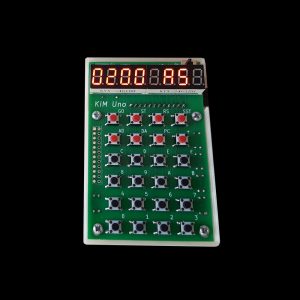
The KIM Uno is a small “open-source hardware” project to build a replica of the classic 1976 KIM-1 computer. It doubles up as a 6502 programmable calculator. It costs about $10 in commonly available parts (board & parts without case or power supply), but provides a faithful KIM-1 ‘experience’. An atMega328 (Arduino Pro Mini, actually) mounted on the back of the board contains all the logic and memory.
The KIM Uno has some of the most interesting 6502 software of that early period built in to ROMs. So you can also play chess, use it as a programmable calculator and experience some of the earliest software development tools written by pioneers like Steve Wozniak, Jim Butterfield and Peter Jennings – dating back to a period when microprocessors had only been in existence for 2-3 years. Software archaeology!
Read More...RC 2014
Posted by musovern on May 23rd, 2019 in RC2014, Single Board Computers | 1 comment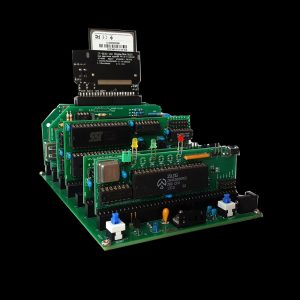
RC2014 is a simple 8 bit Z80 based modular computer originally built to run Microsoft BASIC. It is inspired by the home built computers of the late 70s and computer revolution of the early 80s. It is not a clone of anything specific, but there are suggestions of the ZX81, UK101, S100, Superboard II and Apple I in here. It nominally has 8K ROM, 32K RAM, runs at 7.3728MHz and communicates over serial at 115,200 baud.
Read More...Micro-Elf
Posted by musovern on May 19th, 2019 in Cosmac-Elf, Single Board Computers | 1 comment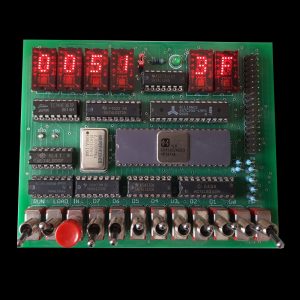
This is based on the Micro- Elf project presented in Popular Electronics. Mike Riley from Elf-emulation.com has designed a PCB to make for easier construction than the wire-wrap method used in my Cosmac Elf.
Read More...SBC-8080A
Posted by musovern on Apr 20th, 2019 in SBC-8080A, Single Board Computers | 0 comments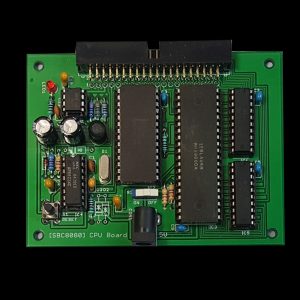
The SBC8080 is a simple board computer consisting of an Intel 8080 based CPU board and a SUB board with a memory / terminal interface. Over time, this product will be the printed circuit board of the CPU board. The parts to be placed on the printed circuit board should be prepared and soldered by yourself. The finished appearance is shown below.
Read More...Talking Electronics TEC-1D
Posted by musovern on Jan 30th, 2019 in Single Board Computers, Talking Electronics TEC-1D | 0 comments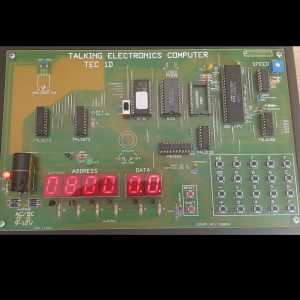
The TEC-1 is a single-board kit computer first produced by the Australian hobbyist electronics magazine Talking Electronics in the early 1980s.[1] The design by John Hardy and Ken Stone was based on the Zilog Z80 CPU, had 2K of RAM and 2K of ROM in a default configuration. Later versions used a 4k ROM with two different versions of the monitor software selectable via a switch. This allowed the early software presented in the magazine to be used with the later version of the TEC-1.
Read More...VeriFone Tranz 330
Posted by musovern on Jan 30th, 2019 in Single Board Computers, VeriFone Tranz 330 | 0 comments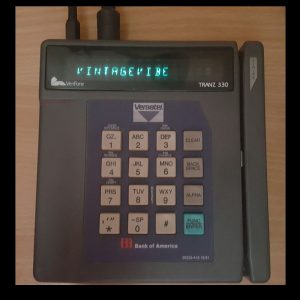
The VeriFone Tranz 330 was a very popular, possibly iconic credit card terminal that was produced almost unchanged from 1985 through the mid ’00s. Inside is a Zilog Z80 running at 3.57MHz (colorburst!), 32K RAM and 32K EPROM, Z80 DART (SIO), Z80 PIO, Z80 CTC, modem, RTC, and the keypad/display. It’s a cookie cutter Z80 SBC design, which makes development pretty easy. They are plentiful and cheap on the used market due to the lack of PCI security (tamper proofing, end to end encryption, etc).
Read More...MiniMax 8085
Posted by musovern on Jan 29th, 2019 in MinMax 8085 | 1 comment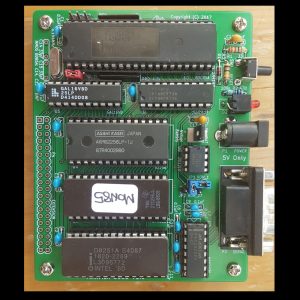
The MiniMax8085 project has been brewing for almost three years. Sometime in the spring of 2014 my kids and I visited local the surplus store, where my kids found some Intel 8000 series parts in the kids-fill-your-bucket area. Among these ICs were there: an 8085 CPU, an 8155 RAM with I/O ports and timer, a couple of 8255 PPIs, an 8282 latch, and some 27C128 UV EPROMs. It looked like a good start for an 8085 based computer that can be used to teach my kids some computer design and programming basics.
I wanted the project to be simple to build, with a minimal number of components, but yet to be a fully functional single board computer (e.g. to include the memory and an input/output device, for example a UART) with an extension bus. I checked the Internet for existing homebrew 8085 computers and found Roman Fülek’s NCB85 and NCB85v2 projects, and Glitch Works 8085 projects. While I liked these projects, they didn’t quite meet my project design goals:
Lawrence Livermore Laboratory MST-80B
Posted by musovern on Sep 14th, 2018 in Lawrence Livermore Laboratory, Single Board Computers | 0 comments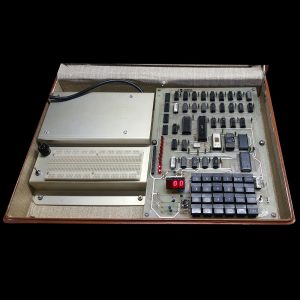
The LLL MST-80B is a complete microcomputer system self-contained in a briefcase for portability and easy usage. The microcomputer was designed as a training device for LLL’s Technology Training Program (TTP), and lowing students to explore the hardware and software capability of a typical microcomputer.
Read More...SBC6120 RBC Edition
Posted by musovern on Sep 12th, 2018 in SBC6120 RBC Edition, Single Board Computers | 0 comments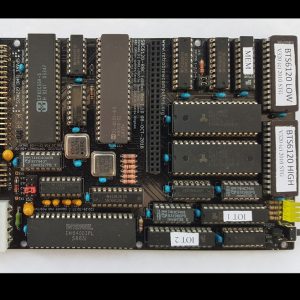
In the late 90s, Robert Armstrong of Spare Time Gizmos designed a single board computer using the Harris HD-6120 CMOS “PDP-8 on a chip”.
Bob no longer offers new SBC6120 kits or boards, be he has made the design documentation, source code, and design files for the SBC6120 available for others to use at the Spare Time Gizmos SBC6120 Page with the following license:
All SBC6120 files are Copyright (C) 2001-2003 by Spare Time Gizmos.
Read More...Z80 SBC-2G-512k
Posted by musovern on Jun 27th, 2018 in Single Board Computers, Z80 SBC-2G-512k | 0 comments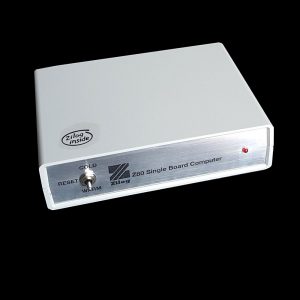
In march 2007 Grant Searle introduced “CP/M on Breadboard”, a 9 chip Z80 CP/M computer using a CF card as mass storage device.
This is the up-to-date version, including 5 CP/M variants and NASCOM Basic
Z80 SBC-2G-512k
Read More...Z80 SBC – Zapple
Posted by musovern on Jun 14th, 2018 in Single Board Computers, Z80 SBC - Zapple | 0 comments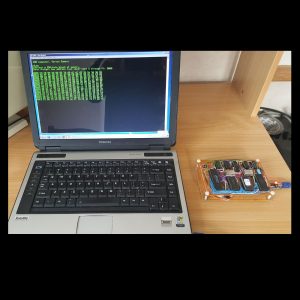
This is a Z80 single board computer that I made some years ago, After reading this excellent book “Build Your Own Z80 Computer Book” by Steve Ciarcia.
I have made a “Zapple like Monitor” it’s a work in progress.
It’s built on a breadboard at the moment. I’ll Design a PCB at some time in the future and expand the RAM to 64k and ROM Monitor to 32k.
Read More...Grant’s 7-chip Z80 computer
Posted by musovern on May 10th, 2018 in Grant's 7 Chip Z80, Single Board Computers | 0 comments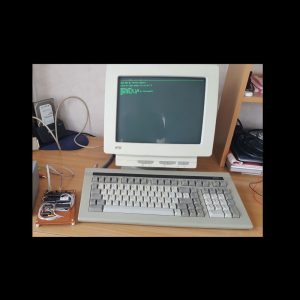
This is my version of Grant Searle’s 7-chip Z80 computer that i made on veroboard a few years back a very simple Z80 design.
The purpose of this computer is to create the simplest possible machine with a high speed interface, good amount of RAM and also a good implementation of BASIC.
The design that Grant produced is shown here, and is probably the simplest Z80 circuit that can be done to fulfill what I needed.
Micro UK101
Posted by musovern on May 10th, 2018 in Micro UK101, Single Board Computers | 0 comments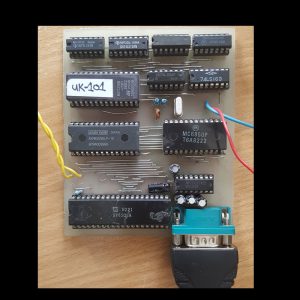
The micro UK101 described here is by Grant Searle effectively the stripped-down “core” of the original UK101, and is no way intended to be the full UK101 implementation. The display and the keyboard circuitry and, instead, used a terminal emulation program (eg HyperTerm for Windows) as the keyboard/display. This has resulted in a very simple circuit which is suitable for use embedded-control applications as well as a fully-functioning computer. I have tried to make as few functional changes as possible to allow old software to work, wherever possible. As a result the BASIC ROM is totally untouched.
Read More...ECB SBC (Z80) Computer
Posted by musovern on May 7th, 2018 in N8VEM, Single Board Computers | 0 comments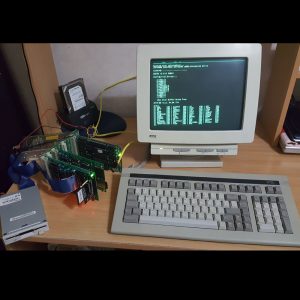
In 2006, Andrew Lynch published his Single-Board CP/M design with the intention to involve others in a collective homebrewing project. The N8VEM (named after his ham radio license) is expandable with add-on cards and soon, an informal collaborative effort emerged around a Google mail group. A web site was set up to share the hard- and software that began to be produced. Builders with a wide range of skills got involved – from well-known systems designers to absolute beginners that bought Andrew’s $20 circuit board to explore CP/M.
Read More...The Multicomp Cyclone II-C
Posted by musovern on May 7th, 2018 in MultiComp Board, Single Board Computers | 0 comments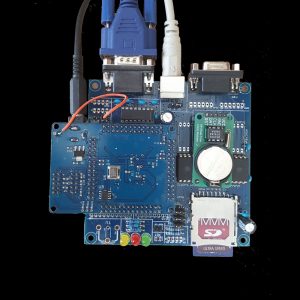
The Multicomp Cyclone II-C (v1.10) is a motherboard which provides peripheral connectivity for a Cyclone II FPGA development board commonly available on eBay. The board was designed “by committee” in the retrobrewcomputers forum during December 2015, with James Moxham doing all the actual work (schematic capture and PCB layout). One of the prime motivators for this board was to fit a 10cmx10cm footprint because the manufacturing cost of PCBs of this size is particularly attractive. It provides connectivity for the following peripherals: (v1.10) is a motherboard which provides peripheral connectivity for a Cyclone II FPGA development board commonly available on eBay. The board was designed “by committee” in the retrobrewcomputers forum during December 2015, with James Moxham doing all the actual work (schematic capture and PCB layout).
Read More...S.D System Z80 Starter Kit
Posted by musovern on May 1st, 2018 in SD System, Single Board Computers | 0 comments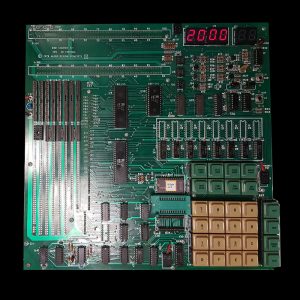
In 1979, S.D. Systems and Micro Design Concepts released the Z80 Starter Kit as an SBC – single board computer.
Able to run either 8080 or Z80 software, it was designed as the best value on the market for the hobbiest / experimenter / student who wants to learn about and work with microcomputers.
The built-in ZBUG Monitor program is a 2,048 byte program written for the Z80 which allows the user to enter and debug machine-level Z80 programs.
Input is accomplished via a hexadecimal keyboard plus 12 command keys.
Output is the 6-digit 7-segment LED display.
The expansion capabilities are vast, with on-board wire wrap area and two optional S-100 bus connectors, although only 45 out of 100 signals are present.
Read More...The Cosmac “Elf”
Posted by musovern on Apr 24th, 2018 in Cosmac-Elf, Single Board Computers | 0 comments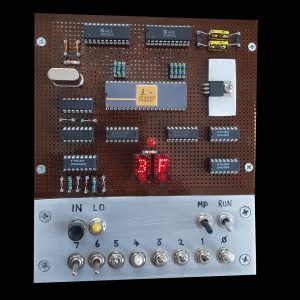
In August 1976 issue of Popular Electronics magazine, Joseph Weisbecker published a design for “Low-cost experimenter’s microcomputer” using RCA’s COSMAC CDP1802 microprocessor chip. It is a very simple computer having 256 bytes of memory, switches as input and LED as output. No ROM, every time you turn it on you have to enter program to RAM by toggling 8 switches, one for each bit. After the switches are set, pressing IN-button stores that byte to memory and increments address. Remember, that it only had 256 bytes of RAM, so it was not that big deal, but still takes some time. There is no way to step address backwards – if you made a mistake you have to start from beginning.
Read More...Super Elf
Posted by musovern on Apr 15th, 2018 in Cosmac-Elf, Single Board Computers | 0 comments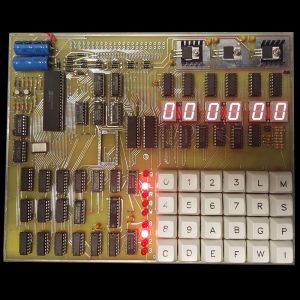
The SuperElf single-board computer was made by Quest Electronics. It was an improvement of the Netronics Elf and Elf II training boards, also based on the RCA 1802, one of the first RISC microprocessors.
The board also featured an 1861 video chip that was closely tied to the 1802 to generate a video image of 128×64 dots.
2, 4 or 6 7-segment Led display could be used. Its hexadecimal keyboard allowed programs to be entered and controlled more efficiently thanks to 8 function keys:
Read More...Pico/ELF
Posted by musovern on Apr 10th, 2018 in Cosmac-Elf, Single Board Computers | 0 comments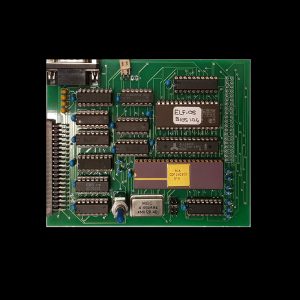
The Pico/Elf is a Micro/Elf derivative. By eliminating the displays and switches (as well as associated circuitry), Mike Riley has been able to add the IDE, Serial port, and Eprom socket. Circuitry has been added to allow the computer to boot from rom by swapping 32k banks until the upper 32k is accessed. This machine also includes the Version 2 Micro/Elf expansion connector. This is an excellent small comptuer for running Elf/OS.
Read More...MPF-1 (MicroProfessor 1)
Posted by musovern on Apr 4th, 2018 in Micro-Professor, Single Board Computers | 0 comments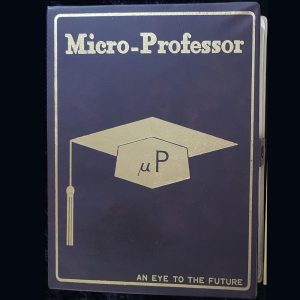
The MPF-1 (MicroProfessor 1) was a computer system specifically designed by Multitech (now known as Acer!) as a learning tool for use in the teaching of microprocessor, microelectronics, and control technology. In the 80’s it was sold as an Z80 CPU learning and initiation system, and believe it or not, it is still in production and sold by http://www.flite.co.uk/.
The capacities of the system were quite poor. The standard model could be programmed only in machine code through a small hexadecimal keyboard. When sold in it’s original package it had the particularity to look like a book when closed.
There was an EPROM socket, which can be compared to a cartridge slot. A mini-Basic EPROM and some other utilities and languages were available as options.
There are in fact two models: MPF-1 (later called MPF-1A) and MPF-1B. The MPF-1(A) is machine code programmed only whereas the MPF-1B offers a really crude version of BASIC (one button = 1 command, as per the early TRS-80) in addition to the machine code capabilities.
Read More...